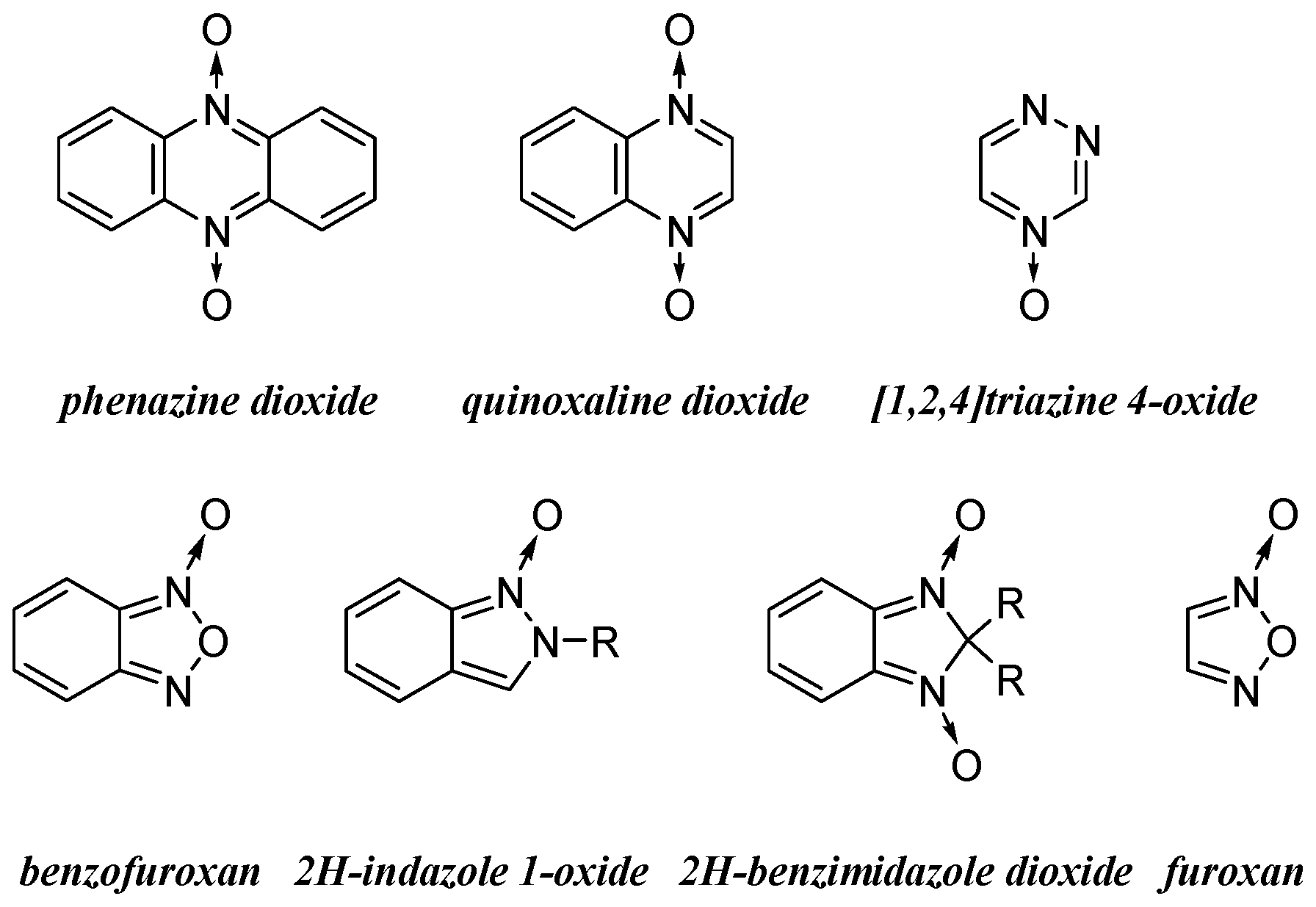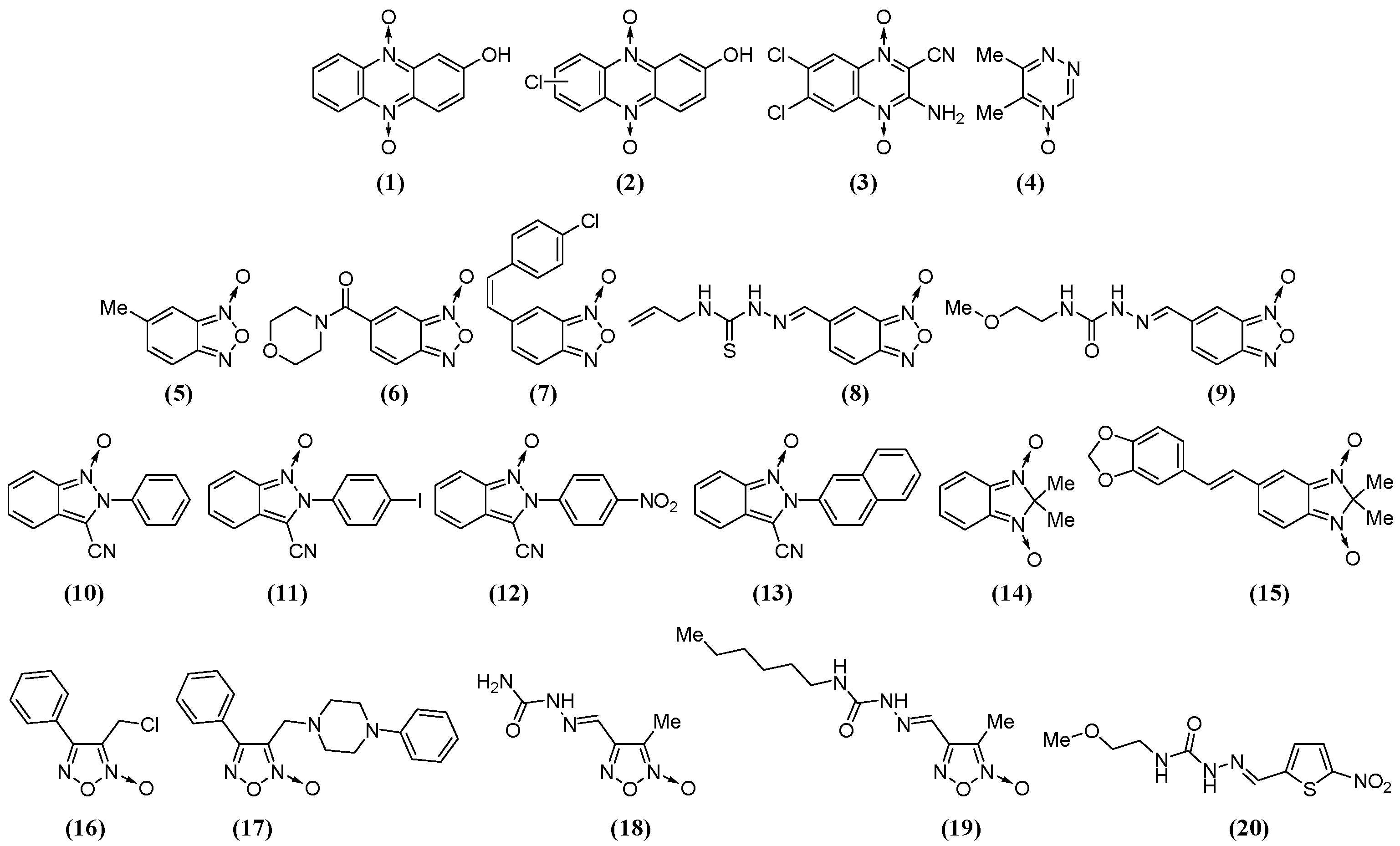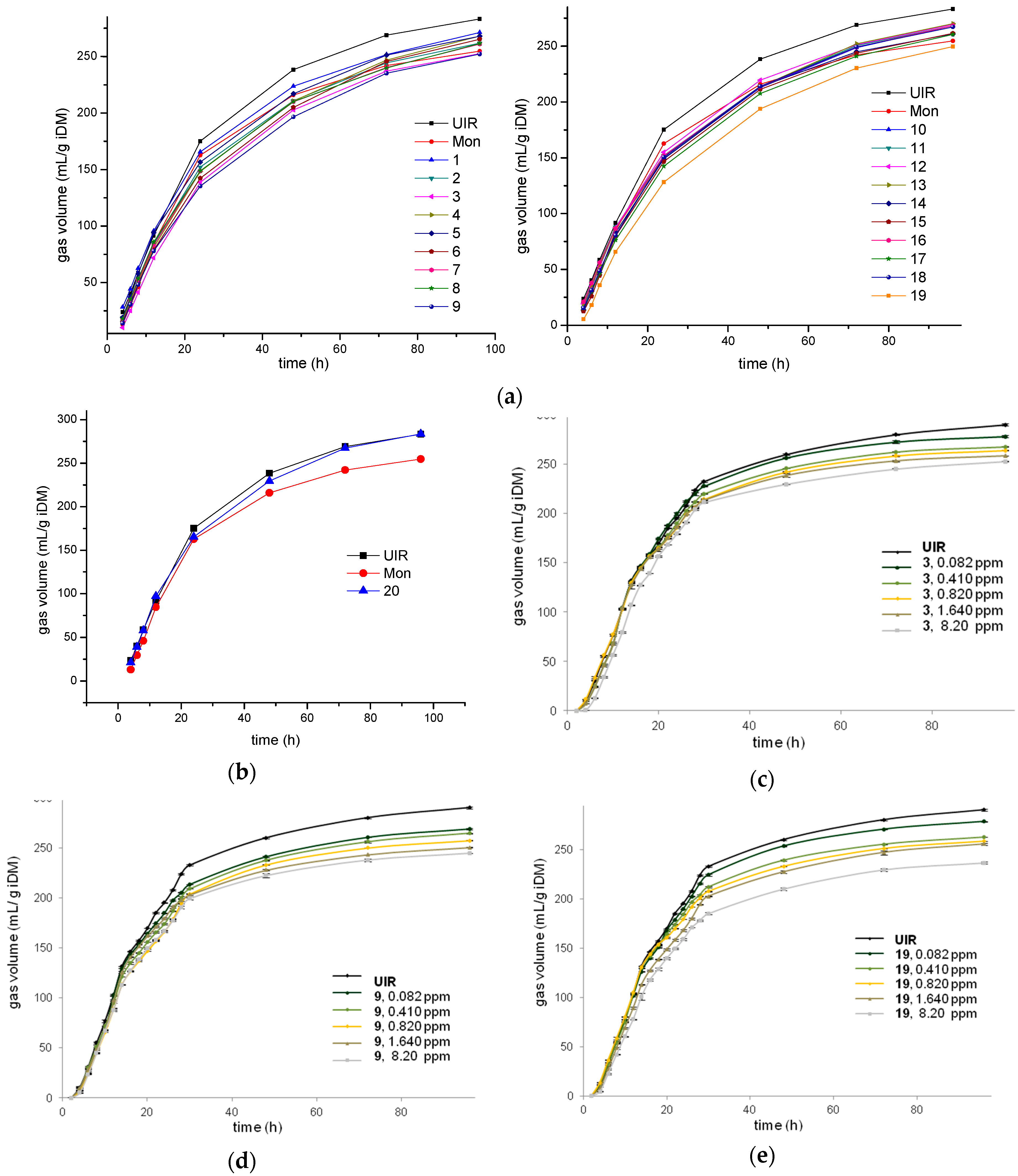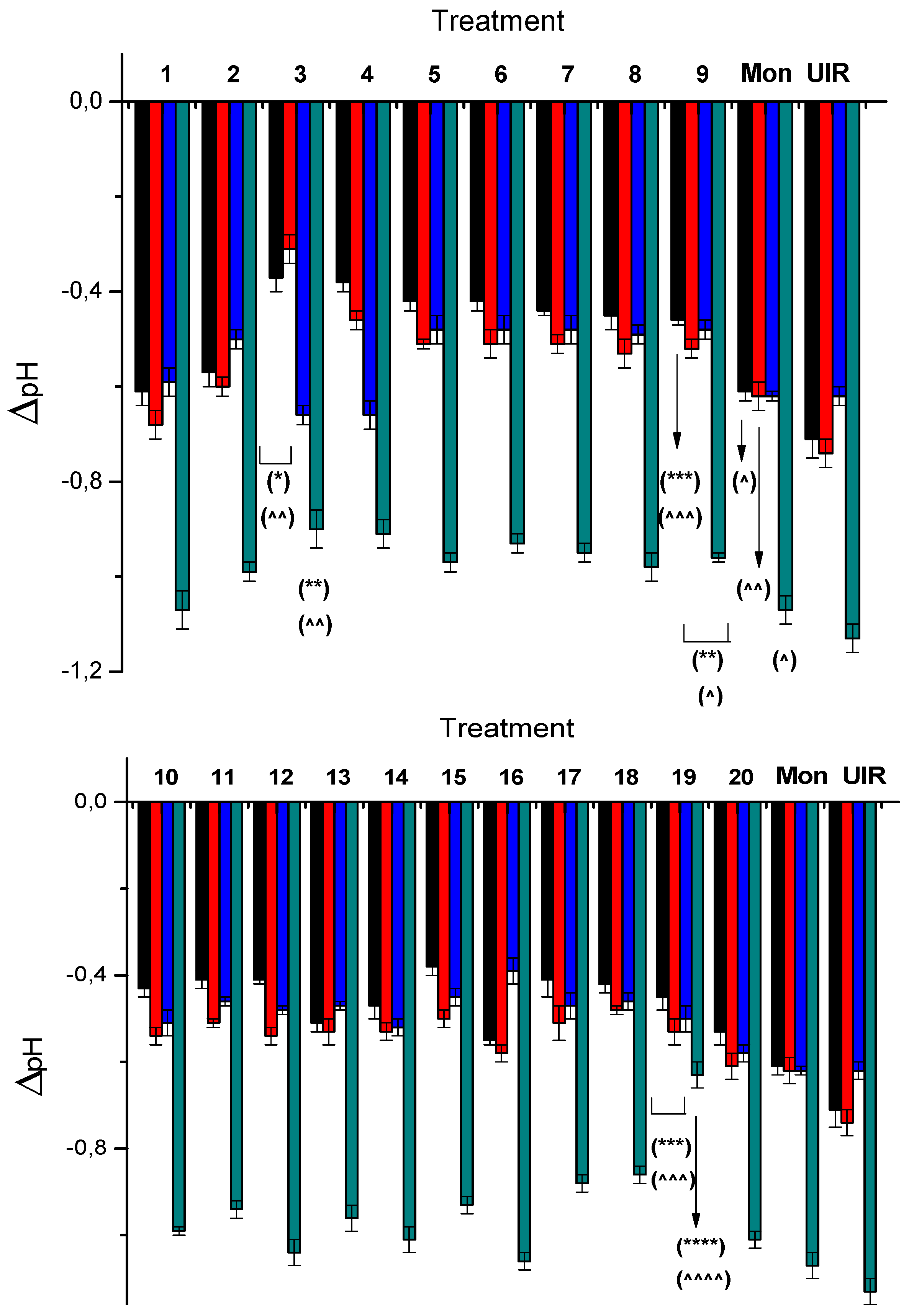Identification of N-Oxide-Containing Aromatic Heterocycles as Pharmacophores for Rumen Fermentation Modifiers
Abstract
1. Introduction
2. Results
2.1. Effect of the Studied Compounds on the Total Gas Production
2.2. Effect of the Studied Compounds on Rumen pH
2.3. Effect of the Studied Compounds on the Rumen Short-chain Fatty Acid (SCFA) Composition. Whole Ruminal Fluid 1H NMR-Metabolic Profile
3. Discussion
4. Materials and Methods
4.1. Studied Compounds
4.2. Experimental Design
4.3. In Vitro Rumen Assays
4.4. NMR Analysis and Data Processing
Supplementary Materials
Author Contributions
Funding
Conflicts of Interest
References
- Miller, T.L. Ecology of methane production and hydrogen sinks in the rumen. In Ruminant Physiology: Digestion, Metabolism, Growth and Reproduction, Proceedings of the 8th International Symposium of Ruminant Physiology; Von Engelhardt, W., Leonhard-Marek, S., Breves, G., Giesecke, D., Eds.; Ferdinand Enke Verlag: Stuttgart, Germany, 1995; pp. 317–331. [Google Scholar]
- United Nations Framework Convention on Climate Change. Greenhouse Gas Inventory Data; United Nations: Bonn, Germany, 2006; Available online: unfccc.int (accessed on 6 December 2018).
- Sarker, N.C.; Keomanivong, F.; Borhan, M.; Rahman, S.; Swanson, K. In vitro evaluation of nano zinc oxide (nZnO) on mitigation of gaseous emissions. J. Anim. Sci. Technol. 2018, 60, 27. [Google Scholar] [CrossRef] [PubMed]
- Bhatta, R.; Saravanan, M.; Baruah, L.; Sampath, K.; Prasad, C.S. Effect of plant secondary compounds on in vitro methane, ammonia production and ruminal protozoa population. J. Appl. Microbiol. 2013, 115, 455–465. [Google Scholar] [CrossRef]
- Flachowsky, G.; Lebzien, P. Effects of phytogenic substances on rumen fermentation and methane emissions: A proposal for a research process. Anim. Feed. Sci. Technol. 2012, 176, 70–77. [Google Scholar] [CrossRef]
- Hook, S.E.; Wright, A.-D.W.; McBride, B.W. Methanogens: Methane producers of the rumen and mitigation strategies. Archaea 2010, 2010, 945785. [Google Scholar] [CrossRef]
- Llonch, P.; Haskell, M.J.; Dewhurst, R.J.; Turner, S.P. Current available strategies to mitigate greenhouse gas emissions in livestock systems: An animal welfare perspective. Animal 2017, 11, 274–284. [Google Scholar] [CrossRef]
- Martin, C.; Morgavi, D.P.; Doreau, M. Methane mitigation in ruminants: From microbe to the farm scale. Animal 2010, 4, 351–365. [Google Scholar] [CrossRef]
- Bodas, R.; Prieto, N.; García-González, R.; Andrés, S.; Giráldez, F.J.; López, S. Manipulation of rumen fermentation and methane production with plant secondary metabolites. Anim. Feed Sci. Technol. 2012, 176, 78–93. [Google Scholar] [CrossRef]
- Abad, P.; Arroyo-Manzanares, N.; Gil, L.; García-Campaña, A.M. Use of onion extract as a dairy cattle feed supplement: Monitoring propyl propane thiosulfonate as a marker of its effect on milk attributes. J. Agric. Food Chem. 2017, 65, 793–799. [Google Scholar] [CrossRef]
- Jafari, S.; Meng, G.Y.; Rajion, M.A.; Jahromi, M.F.; Ebrahimi, M. Manipulation of rumen microbial fermentation by polyphenol rich solvent fractions from Papaya leaf to reduce green-house gas methane and biohydrogenation of C18 PUFA. J. Agric. Food Chem. 2016, 64, 4522–4530. [Google Scholar] [CrossRef]
- Santana, A.; Ríos, J.A.; González, M.; Cerecetto, H.; Cajarville, C.; Repetto, J.L. Use of ethanol extracts of Schinus longifolius (Molle) and Eucalyptus grandis (Eucalipto) to modulate the in vitro fermentation and protein degradation estimated by the concentration of ammonia N. Veterinaria (Montevideo) 2012, 48, 15–19. [Google Scholar]
- Cabrera, M.; Mastandrea, I.; Otero, G.; Cerecetto, H.; González, M. In vivo phase II-enzymes inducers, as potential chemopreventive agents, based on the chalcone and furoxan skeletons. Bioorg. Med. Chem. 2016, 24, 1665–1674. [Google Scholar] [CrossRef]
- Fernández, S.; Berchesi, A.; Tejeria, E.; Sanz, I.; Cerecetto, H.; González, M.; Lavaggi, M.L.; Rey, A. Preparation and biological evaluation of (99m)Tc-labelled phenazine dioxides as potential tracers for hypoxia imaging. Curr. Radiopharm. 2015, 8, 56–61. [Google Scholar] [CrossRef] [PubMed]
- Dos Santos, J.L.; Lanaro, C.; Chelucci, R.C.; Gambero, S.; Bosquesi, P.L.; Reis, J.S.; Lima, L.M.; Cerecetto, H.; González, M.; Costa, F.F.; Chung, M.C. Design, synthesis, and pharmacological evaluation of novel hybrid compounds to treat sickle cell disease symptoms. Part II: Furoxan derivatives. J. Med. Chem. 2012, 55, 7583–7592. [Google Scholar] [CrossRef]
- Hernández, P.; Cabrera, M.; Lavaggi, M.L.; Celano, L.; Tiscornia, I.; Rodrigues da Costa, T.; Thomson, L.; Bollati-Fogolín, M.; Miranda, A.L.; Lima, L.M.; et al. Discovery of new orally effective analgesic and anti-inflammatory hybrid furoxanyl N-acylhydrazone derivatives. Bioorg. Med. Chem. 2012, 20, 2158–2171. [Google Scholar] [CrossRef]
- Cerecetto, H.; Dias, E.; Di Maio, R.; González, M.; Pacce, S.; Saenz, P.; Seoane, G.; Suescun, L.; Mombrú, A.; Fernández, G.; et al. Synthesis and herbicidal activity of N-oxide derivatives. J. Agric. Food Chem. 2000, 48, 2995–3002. [Google Scholar] [CrossRef] [PubMed]
- Monge, A.; López de Ceráin, A.; Ezpeleta, O.; Cerecetto, H.; Dias, E.; Di Maio, R.; González, M.; Onetto, S.; Seoane, G.; Suescun, L.; et al. Synthesis and biological evaluation of 1,2,5-oxadiazole N-oxide derivatives as hypoxia-selective cytotoxins. Pharmazie 1998, 53, 758–764. [Google Scholar] [PubMed]
- Lavaggi, M.L.; Aguirre, G.; Boiani, L.; Orelli, L.; García, B.; Cerecetto, H.; González, M. Pyrimido [1,2-a]quinoxaline 6-oxide and phenazine 5,10-dioxide derivatives and related compounds as growth inhibitors of Trypanosoma cruzi. Eur. J. Med. Chem. 2008, 43, 1737–1741. [Google Scholar] [CrossRef]
- Benitez, D.; Cabrera, M.; Hernández, P.; Boiani, L.; Lavaggi, M.L.; Di Maio, R.; Yaluff, G.; Serna, E.; Torres, S.; Ferreira, M.E.; et al. 3-Trifluoromethylquinoxaline N,N′-dioxides as anti-trypanosomatid agents. Identification of optimal anti-T. cruzi agents and mechanism of action studies. J. Med. Chem. 2011, 54, 3624–3636. [Google Scholar] [CrossRef] [PubMed]
- Gerpe, A.; Aguirre, G.; Boiani, L.; Cerecetto, H.; González, M.; Olea-Azar, C.; Rigol, C.; Maya, J.D.; Morello, A.; Piro, O.E.; et al. Indazole N-oxide derivatives as antiprotozoal agents: Synthesis, biological evaluation and mechanism of action studies. Bioorg. Med. Chem. 2006, 14, 3467–3480. [Google Scholar] [CrossRef]
- Castro, D.; Boiani, L.; Benitez, D.; Hernández, P.; Merlino, A.; Gil, C.; Olea-Azar, C.; González, M.; Cerecetto, H.; Porcal, W. Anti-trypanosomatid benzofuroxans and deoxygenated analogues: Synthesis using polymer-supported triphenylphosphine, biological evaluation and mechanism of action studies. Eur. J. Med. Chem. 2009, 44, 5055–5065. [Google Scholar] [CrossRef]
- Cerecetto, H.; Di Maio, R.; González, M.; Risso, M.; Saenz, P.; Seoane, G.; Denicola, A.; Peluffo, G.; Quijano, C.; Olea-Azar, C. 1,2,5-Oxadiazole N-oxide derivatives and related compounds as potential antitrypanosomal drugs: Structure-activity relationships. J. Med. Chem. 1999, 42, 1941–1950. [Google Scholar] [CrossRef]
- Boiani, M.; Boiani, L.; Denicola, A.; Torres de Ortiz, S.; Serna, E.; Vera de Bilbao, N.; Sanabria, L.; Yaluff, G.; Nakayama, H.; Rojas de Arias, A.; et al. 2H-benzimidazole 1,3-dioxide derivatives: A new family of water-soluble anti-trypanosomatid agents. J. Med. Chem. 2006, 49, 3215–3224. [Google Scholar] [CrossRef]
- Hernández, P.; Rojas, R.; Gilman, R.H.; Sauvain, M.; Lima, L.M.; Barreiro, E.J.; González, M.; Cerecetto, H. Hybrid furoxanyl N-acylhydrazone derivatives as hits for the development of neglected diseases drug candidates. Eur. J. Med. Chem. 2013, 59, 64–74. [Google Scholar] [CrossRef]
- Yadav, P.; Marshall, A.J.; Reynisson, J.; Denny, W.A.; Hay, M.P.; Anderson, R.F. Fragmentation of the quinoxaline N-oxide bond to the ˙OH radical upon one-electron bioreduction. Chem. Commun. (Camb.) 2014, 50, 13729–13731. [Google Scholar] [CrossRef]
- Torres, E.; Moreno-Viguri, E.; Galiano, S.; Devarapally, G.; Crawford, P.W.; Azqueta, A.; Varela, J.; Birriel, E.; Di Maio, R.; Cerecetto, H.; et al. Novel quinoxaline 1,4-di-N-oxide derivatives as new potential antichagasic agents. Eur. J. Med. Chem. 2013, 66, 324–334. [Google Scholar] [CrossRef] [PubMed]
- Reybier, K.; Nguyen, T.H.; Ibrahim, H.; Perio, P.; Montrose, A.; Fabre, P.L.; Nepveu, F. Electrochemical behavior of indolone-N-oxides: Relationship to structure and antiplasmodial activity. Bioelectrochemistry 2012, 88, 57–64. [Google Scholar] [CrossRef] [PubMed]
- Lavaggi, M.L.; Nieves, M.; Cabrera, M.; Olea-Azar, C.; López de Ceráin, A.; Monge, A.; Cerecetto, H.; González, M. Structural modifications on the phenazine N,N′-dioxide-scaffold looking for new selective hypoxic cytotoxins. Eur. J. Med. Chem. 2010, 45, 5362–5369. [Google Scholar] [CrossRef] [PubMed]
- Olea-Azar, C.; Rigol, C.; Mendizábal, F.; Briones, R.; Cerecetto, H.; Di Maio, R.; Risso, M.; González, M.; Porcal, W. Electrochemical and microsomal production of free radicals from 1,2,5-oxadiazole N-oxide as potential antiprotozoal drugs. Spectrochim. Acta A Mol. Biomol. Spectrosc. 2003, 59, 69–74. [Google Scholar] [CrossRef]
- Tocher, J.H.; Edwards, D.I. Electrochemical studies of tirapazamine: Generation of the one-electron reduction product. Free Radic. Res. 1994, 21, 277–283. [Google Scholar] [CrossRef]
- Lorenzen, J.; Steinwachs, S.; Unden, G. DMSO respiration by the anaerobic rumen bacterium Wolinella succinogenes. Arch. Microbiol. 1994, 162, 277–281. [Google Scholar] [CrossRef]
- Cerecetto, V.; Diaz-Viraqué, F.; Irazoqui, I.; Rodríguez, A.; Cajarville, C.; Repetto, J.L.; Lavaggi, M.L.; González, M.; Cerecetto, H. Anaerobic biotransformation of N-oxide containing aromatic heterocycles by bovine ruminal fluid. Rev. Virtual Quim. 2013, 5, 1134–1144. [Google Scholar] [CrossRef]
- García, V.; Catalá-Gregori, P.; Madrid, J.; Hernández, F.; Megías, M.D.; Andrade-Montemayor, H.M. Potential of carvacrol to modify in vitro rumen fermentation as compared with monensin. Animal 2007, 1, 675–680. [Google Scholar] [CrossRef]
- McDonald, J. A revised model for the estimation of protein degradability in the rumen. J. Agric. Sci. 1981, 96, 251–252. [Google Scholar] [CrossRef]
- Filípek, J.; Dvořák, R. Determination of the volatile fatty acid content in the rumen liquid: Comparison of gas chromatography and capillary isotachophoresis. Acta Vet. Brno 2009, 78, 627–633. [Google Scholar] [CrossRef]
- Attaelmannan, M.A.; Dahl, A.A.; Reid, R.S. Analysis of volatile fatty acids in rumen fluid by proton NMR spectroscopy. Can. J. Anim. Sci. 1999, 79, 401–404. [Google Scholar] [CrossRef]
- Benítez, D.; Casanova, G.; Cabrera, G.; Galanti, N.; Cerecetto, H.; González, M. Initial studies on mechanism of action and cell death of active N-oxide-containing heterocycles in Trypanosoma cruzi epimastigotes in vitro. Parasitology 2014, 141, 682–696. [Google Scholar] [CrossRef]
- Fraga, M.; Fernández, S.; Cajarville, C.; Martínez, M.; Abin-Carriquiry, J.A.; Zunino, P. In vitro modulation of rumen microbiota and fermentation by native microorganisms isolated from the rumen of a fed-exclusively-on-pasture bovine. Ann. Microbiol. 2015, 65, 2355–2362. [Google Scholar] [CrossRef]
- Dini, Y.; Gere, J.; Cajarville, C.; Ciganda, V. Using highly nutritious pastures to mitigate enteric methane emissions from cattle grazing systems in South America. Anim. Prod. Sci. 2017, 58, 2329–2334. [Google Scholar] [CrossRef]
- Xu, F.; Cheng, G.; Hao, H.; Wang, Y.; Wang, X.; Chen, D.; Peng, D.; Liu, Z.; Yuan, Z.; Dai, M. Mechanisms of antibacterial action of quinoxaline 1,4-di-N-oxides against Clostridium perfringens and Brachyspira hyodysenteriae. Front. Microbiol. 2016, 7, 1948. [Google Scholar] [CrossRef] [PubMed]
- Looft, T.; Allen, H.K.; Casey, T.A.; Alt, D.P.; Stanton, T.B. Carbadox has both temporary and lasting effects on the swine gut microbiota. Front. Microbiol. 2014, 5, 276. [Google Scholar] [CrossRef]
- Wang, X.; Martínez, M.A.; Cheng, G.; Liu, Z.; Huang, L.; Dai, M.; Chen, D.; Martínez-Larrañaga, M.R.; Anadón, A.; Yuan, Z. The critical role of oxidative stress in the toxicity and metabolism of quinoxaline 1,4-di-N-oxides in vitro and in vivo. Drug Metab. Rev. 2016, 48, 159–182. [Google Scholar] [CrossRef]
- Monge, A.; Palop, J.A.; López de Ceráin, A.; Senador, V.; Martínez, F.J.; Sainz, Y.; Narro, S.; García, E.; de Miguel, C.; González, M.; et al. Hypoxia-selective agents derived from quinoxaline 1,4-di-N-oxides. J. Med. Chem. 1995, 38, 1786–1792. [Google Scholar] [CrossRef] [PubMed]
- Gabay, M.; Cabrera, M.; Di Maio, R.; Paez, J.A.; Campillo, N.; Lavaggi, M.L.; Cerecetto, H.; González, M. Mutagenicity of N-oxide containing heterocycles and related compounds: Experimental and theoretical studies. Curr. Top. Med. Chem. 2014, 14, 1374–1387. [Google Scholar] [CrossRef] [PubMed]
- Cabrera, M.; López, G.V.; Gómez, L.E.; Breijo, M.; Pintos, C.; Botti, H.; Raymondo, S.; Vettorazzi, A.; López de Ceráin, A.; Monge, A.; et al. Genetic toxicology and preliminary in vivo studies of nitric oxide donor tocopherol analogs as potential new class of antiatherogenic agents. Drug Chem. Toxicol. 2011, 34, 285–293. [Google Scholar] [CrossRef] [PubMed]
- Humer, E.; Aschenbach, J.R.; Neubauer, V.; Kröger, I.; Khiaosa-Ard, R.; Baumgartner, W.; Zebeli, Q. Signals for identifying cows at risk of subacute ruminal acidosis in dairy veterinary practice. J. Anim. Physiol. Anim. Nutr. (Berl.) 2018, 102, 380–392. [Google Scholar] [CrossRef]
- Cooper, R.J.; Klopfenstein, T.J.; Stock, R.A.; Milton, C.T.; Herold, D.W.; Parrott, J.C. Effects of imposed feed intake variation on acidosis and performance of finishing steers. J. Anim. Sci. 1999, 77, 1093–1099. [Google Scholar] [CrossRef] [PubMed]
- Russell, J.B. The importance of pH in the regulation of ruminal acetate to propionate ratio and methane production. J. Dairy Sci. 1998, 81, 3222–3230. [Google Scholar] [CrossRef]
- Cajarville, C.; Britos, A.; Errandonea, N.; Gutiérrez, L.; Cozzolino, D.; Repetto, J.L. Diurnal changes in water-soluble carbohydrate concentration in lucerne and tall fescue in autumn and the effects on in vitro fermentation. N. Zeal. J. Agric. Res. 2015, 58, 281–291. [Google Scholar] [CrossRef]
- Williams, B.; Bosch, M.; Boer, H.; Verstegen, M.; Tamminga, S. An in vitro batch culture method to assess potential fermentability of feed ingredients for monogastric diets. Anim. Feed Sci. Technol. 2005, 123–124, 445–462. [Google Scholar] [CrossRef]
- Varela, J.; Serna, E.; Torres, S.; Yaluff, G.; Vera de Bilbao, N.I.; Miño, P.; Chiriboga, X.; Cerecetto, H.; González, M. In vivo anti-Trypanosoma cruzi activity of hydro-ethanolic extract and isolated active principles from Aristeguietia glutinosa and mechanism of action studies. Molecules 2014, 19, 8488–8502. [Google Scholar] [CrossRef] [PubMed]
- Couto, M.; Sánchez, C.; Dávila, B.; Machín, V.; Varela, J.; Álvarez, G.; Cabrera, M.; Celano, L.; Aguirre-López, B.; Cabrera, N.; et al. 3-H-[1,2]Dithiole as a new anti-Trypanosoma cruzi chemotype: Biological and mechanism of action studies. Molecules 2015, 20, 14595–14610. [Google Scholar] [CrossRef] [PubMed]
- Varela, J.; Birriel, E.; Nargoli, J.; Faral-Tello, P.; Robello, C.; Coqueiro, A.; Choi, Y.H.; Cerecetto, H.; González, M. Identification of new anti-Trypanosoma cruzi agents in some Uruguayan plants by NMR-based metabolomic profiling. Arch. Nat. Med. Chem. 2017, ANMC-105. [Google Scholar] [CrossRef]
- O’Callaghan, T.F.; Vázquez-Fresno, R.; Serra-Cayuela, A.; Dong, E.; Mandal, R.; Hennessy, D.; McAuliffe, S.; Dillon, P.; Wishart, D.S.; Stanton, C.; et al. Pasture feeding changes the bovine rumen and milk metabolome. Metabolites 2018, 8, 27. [Google Scholar] [CrossRef]




| Ratios | [Ac]/[Prop] 1,2 | [Ac]/[But] 1 | ||
|---|---|---|---|---|
| Time Post Inoculation | 12 h | 96 h | 12 h | 96 h |
| 3 | 2.25 (***),(#),(&) | 2.07 (***),(&) | 3.41 (****),(^),(####),(&),(++) | 2.79 (^^^^),(&),(++) |
| 9 | 2.58 (****),(^),(&&),(++++) | 2.05 (***),(&) | 4.03 (^^^^),(&&&&),(++++) | 2.78 (^^^^),(&),(++) |
| 19 | 2.02 (^),(+) | 1.92 (^^),(++) | 3.19 (****)c | 2.67 (*),(^^^^),(++) |
| Mon | 1.94 (^^),(++) | 1.54 (^^^),(+++) | 4.01 (^^^^),(++++) | 2.81 (^^),(+) |
| 20 | 2.15 | 2.16 | 3.14 | 3.26 |
| UIR | 2.21 | 2.15 | 3.28 | 3.56 |
© 2019 by the authors. Licensee MDPI, Basel, Switzerland. This article is an open access article distributed under the terms and conditions of the Creative Commons Attribution (CC BY) license (http://creativecommons.org/licenses/by/4.0/).
Share and Cite
Bonifacino, C.; Rodríguez, G.; Pérez-Ruchel, A.; Repetto, J.L.; Cerecetto, H.; Cajarville, C.; González, M. Identification of N-Oxide-Containing Aromatic Heterocycles as Pharmacophores for Rumen Fermentation Modifiers. Metabolites 2019, 9, 62. https://doi.org/10.3390/metabo9040062
Bonifacino C, Rodríguez G, Pérez-Ruchel A, Repetto JL, Cerecetto H, Cajarville C, González M. Identification of N-Oxide-Containing Aromatic Heterocycles as Pharmacophores for Rumen Fermentation Modifiers. Metabolites. 2019; 9(4):62. https://doi.org/10.3390/metabo9040062
Chicago/Turabian StyleBonifacino, Carla, Gonzalo Rodríguez, Analía Pérez-Ruchel, José Luis Repetto, Hugo Cerecetto, Cecilia Cajarville, and Mercedes González. 2019. "Identification of N-Oxide-Containing Aromatic Heterocycles as Pharmacophores for Rumen Fermentation Modifiers" Metabolites 9, no. 4: 62. https://doi.org/10.3390/metabo9040062
APA StyleBonifacino, C., Rodríguez, G., Pérez-Ruchel, A., Repetto, J. L., Cerecetto, H., Cajarville, C., & González, M. (2019). Identification of N-Oxide-Containing Aromatic Heterocycles as Pharmacophores for Rumen Fermentation Modifiers. Metabolites, 9(4), 62. https://doi.org/10.3390/metabo9040062






